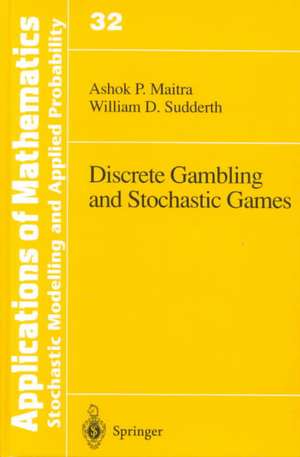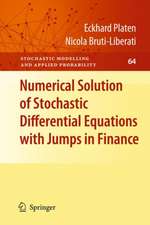Discrete Gambling and Stochastic Games: Stochastic Modelling and Applied Probability, cartea 32
Autor Ashok P. Maitra, William D. Sudderthen Limba Engleză Hardback – 14 mar 1996
| Toate formatele și edițiile | Preț | Express |
|---|---|---|
| Paperback (1) | 638.57 lei 6-8 săpt. | |
| Springer – 17 sep 2011 | 638.57 lei 6-8 săpt. | |
| Hardback (1) | 644.63 lei 6-8 săpt. | |
| Springer – 14 mar 1996 | 644.63 lei 6-8 săpt. |
Din seria Stochastic Modelling and Applied Probability
- 17%
 Preț: 464.63 lei
Preț: 464.63 lei - 18%
 Preț: 805.44 lei
Preț: 805.44 lei - 18%
 Preț: 1110.72 lei
Preț: 1110.72 lei - 18%
 Preț: 947.35 lei
Preț: 947.35 lei -
 Preț: 390.84 lei
Preț: 390.84 lei - 18%
 Preț: 952.40 lei
Preț: 952.40 lei - 15%
 Preț: 648.56 lei
Preț: 648.56 lei - 18%
 Preț: 951.91 lei
Preț: 951.91 lei - 15%
 Preț: 637.13 lei
Preț: 637.13 lei - 18%
 Preț: 793.63 lei
Preț: 793.63 lei -
 Preț: 391.02 lei
Preț: 391.02 lei -
 Preț: 401.42 lei
Preț: 401.42 lei - 15%
 Preț: 639.08 lei
Preț: 639.08 lei - 18%
 Preț: 733.33 lei
Preț: 733.33 lei - 18%
 Preț: 785.11 lei
Preț: 785.11 lei - 15%
 Preț: 593.42 lei
Preț: 593.42 lei - 18%
 Preț: 1114.96 lei
Preț: 1114.96 lei - 15%
 Preț: 643.16 lei
Preț: 643.16 lei -
 Preț: 390.63 lei
Preț: 390.63 lei - 15%
 Preț: 645.60 lei
Preț: 645.60 lei - 15%
 Preț: 641.71 lei
Preț: 641.71 lei - 18%
 Preț: 954.62 lei
Preț: 954.62 lei - 15%
 Preț: 645.14 lei
Preț: 645.14 lei - 18%
 Preț: 947.50 lei
Preț: 947.50 lei - 18%
 Preț: 804.96 lei
Preț: 804.96 lei - 20%
 Preț: 469.59 lei
Preț: 469.59 lei - 20%
 Preț: 581.39 lei
Preț: 581.39 lei
Preț: 644.63 lei
Preț vechi: 758.38 lei
-15% Nou
Puncte Express: 967
Preț estimativ în valută:
123.35€ • 131.90$ • 102.85£
123.35€ • 131.90$ • 102.85£
Carte tipărită la comandă
Livrare economică 17 aprilie-01 mai
Preluare comenzi: 021 569.72.76
Specificații
ISBN-13: 9780387946283
ISBN-10: 0387946284
Pagini: 244
Ilustrații: XII, 244 p.
Dimensiuni: 156 x 234 x 19 mm
Greutate: 0.54 kg
Ediția:1996
Editura: Springer
Colecția Springer
Seria Stochastic Modelling and Applied Probability
Locul publicării:New York, NY, United States
ISBN-10: 0387946284
Pagini: 244
Ilustrații: XII, 244 p.
Dimensiuni: 156 x 234 x 19 mm
Greutate: 0.54 kg
Ediția:1996
Editura: Springer
Colecția Springer
Seria Stochastic Modelling and Applied Probability
Locul publicării:New York, NY, United States
Public țintă
ResearchCuprins
1 Introduction.- 1.1 Preview.- 1.2 Prerequisites.- 1.3 Numbering.- 2 Gambling Houses and the Conservation of Fairness.- 2.1 Introduction.- 2.2 Gambles, Gambling Houses, and Strategies.- 2.3 Stopping Times and Stop Rules.- 2.4 An Optional Sampling Theorem.- 2.5 Martingale Convergence Theorems.- 2.6 The Ordinals and Transfinite Induction.- 2.7 Uncountable State Spaces and Continuous-Time.- 2.8 Problems for Chapter 2.- 3 Leavable Gambling Problems.- 3.1 The Fundamental Theorem.- 3.2 The One-Day Operator and the Optimality Equation.- 3.3 The Utility of a Strategy.- 3.4 Some Examples.- 3.5 Optimal Strategies.- 3.6 Backward Induction: An Algorithm for U.- 3.7 Problems for Chapter 3.- 4 Nonleavable Gambling Problems.- 4.1 Introduction.- 4.2 Understanding u(?).- 4.3 A Characterization of V.- 4.4 The Optimality Equation for V.- 4.5 Proving Optimality.- 4.6 Some Examples.- 4.7 Optimal Strategies.- 4.8 Another Characterization of V.- 4.9 An Algorithm for V.- 4.10 Problems for Chapter 4.- 5 Stationary Families of Strategies.- 5.1 Introduction.- 5.2 Comparing Strategies.- 5.3 Finite Gambling Problems.- 5.4 Nonnegative Stop-or-Go Problems.- 5.5 Leavable Houses.- 5.6 An Example of Blackwell and Ramakrishnan.- 5.7 Markov Families of Strategies.- 5.8 Stationary Plans in Dynamic Programming.- 5.9 Problems for Chapter 5.- 6 Approximation Theorems.- 6.1 Introduction.- 6.2 Analytic Sets.- 6.3 Optimality Equations.- 6.4 Special Cases of Theorem 1.2.- 6.5 The Going-Up Property of $$ \overline M $$.- 6.6 Dynamic Capacities and the Proof of Theorem 1.2.- 6.7 Approximating Functions.- 6.8 Composition Closure and Saturated House.- 6.9 Problems for Chapter 6.- 7 Stochastic Games.- 7.1 Introduction.- 7.2 Two-Person, Zero-Sum Games.- 7.3 The Dynamics of Stochastic Games.- 7.4 Stochastic Games withlim sup Payoff.- 7.5 Other Payoff Functions.- 7.6 The One-Day Operator.- 7.7 Leavable Games.- 7.8 Families of Optimal Strategies for Leavable Games.- 7.9 Examples of Leavable Games.- 7.10 A Modification of Leavable Games and the Operator T.- 7.11 An Algorithm for the Value of a Nonleavable Game.- 7.12 The Optimality Equation for V.- 7.13 Good Strategies in Nonleavable Games.- 7.14 Win, Lose, or Draw.- 7.15 Recursive Matrix Games.- 7.16 Games of Survival.- 7.17 The Big Match.- 7.18 Problems for Chapter 7.- References.- Symbol Index.













